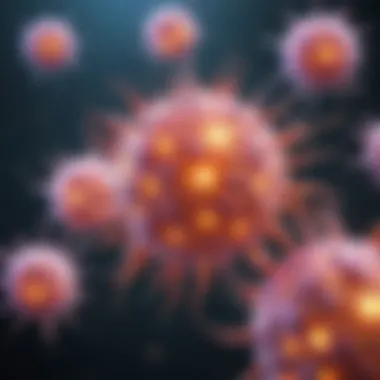Understanding Endocrine Resistant Breast Cancer


Intro
Endocrine resistant breast cancer (ERBC) poses significant challenges to treatment and patient outcomes. It occurs when hormone receptor-positive breast cancers stop responding to hormone therapy, usually after an initial period of effectiveness. This resistance can be biological and often varies from patient to patient, reflecting the complex nature of the disease.
Recent studies reveal that ERBC is not merely a consequence of treatment failure; rather, it entails intricate mechanisms at the molecular level. Understanding these fundamental processes is crucial for developing more effective therapies and improving prognosis for affected individuals.
In this article, we will venture into various aspects of endocrine resistant breast cancer. We will examine recent advances in research and treatment, discuss various methodologies employed in this field, and explore the implications for clinical practice. By synthesizing findings from contemporary studies, we aim to provide valuable insights into the complexities surrounding this disease.
Overview of Endocrine Resistant Breast Cancer
The topic of endocrine resistant breast cancer is crucial in understanding the complexities presented in oncology today. Here, we will dive into the nuances of this condition, which represents a major challenge for both patients and healthcare providers. The phenomenon of endocrine resistance alters treatment outcomes and significantly influences management strategies. Therefore, this overview serves as a foundation for discussing broader implications and strategies relevant to this field.
Definition and Significance
Endocrine resistant breast cancer refers to a subtype of breast cancer that no longer responds effectively to hormone therapies that are typically employed to manage hormone receptor-positive tumors. Hormone receptor-positive breast cancer often relies on estrogen to fuel its growth. Treatments like tamoxifen and aromatase inhibitors work to block this hormonal impact. However, when cancer cells develop resistance to these therapies, management becomes far more complicated.
The significance of recognizing and understanding this resistance lies in its impact on patient prognosis and treatment plans. As resistance develops, cancer can progress, sometimes leading to metastasis and worsening health outcomes. Thorough research into the mechanisms behind this resistance is essential for developing new treatment strategies that can enhance patient survival rates and quality of life.
Epidemiology
The epidemiology of endocrine resistant breast cancer underscores its prevalence and the need for focused research. Studies indicate that approximately 70% of breast cancers express hormone receptors, and a notable fraction of these cases will eventually exhibit resistance to hormonal therapy.
Factors influencing the occurrence of endocrine resistance include age, genetic predisposition, and treatment history. A history of prior cancer treatments can heighten the chance of developing resistance. Additionally, there are observed variations across different populations, making it imperative for researchers to consider demographic factors when studying this condition.
"Understanding how diverse populations respond to endocrine therapies can bring about tailored treatment options that optimize care and outcomes."
Efforts to gather extensive epidemiological data are ongoing. Such data can unlock insights, guiding better preventive measures and treatments in managing this challenging aspect of breast cancer.
In summary, endocrne resistant breast cancer is a significant area of study that impacts the management of hormone receptor-positive tumors. Awareness of its definition and the epidemiological factors associated with it is vital for both clinical practice and research. Through this lens, we can start to map out the clinical implications and therapeutic advancements that represent the future of breast cancer treatment.
Hormone Receptor-Positive Breast Cancer
Hormone receptor-positive breast cancer is a subtype characterized by the presence of hormone receptors, specifically estrogen and progesterone receptors, on the surface of tumor cells. This characteristic plays a crucial role in tumor behavior and treatment approaches. Understanding this subtype is essential due to its significant implications in the management of breast cancer. Hormone receptor positivity often indicates that a tumor may respond to hormonal therapies, such as tamoxifen or aromatase inhibitors. However, the development of endocrine resistance complicates treatment strategies, making it vital to explore the nuances of this subtype.
Biological Characteristics
The biological characteristics of hormone receptor-positive breast cancer provide valuable insight into its pathophysiology. These tumors often exhibit distinct molecular profiles influenced by hormonal signaling pathways. The presence of estrogen receptors allows estrogen to bind and promote tumor growth. This connection emphasizes why hormonal therapies are frequently effective. However, despite the initial responsiveness to treatment, many patients experience resistance over time. Genetic mutations and alterations in signaling pathways are among the factors that can influence tumor behavior, leading to the development of endocrine-resistant phenotypes.
Furthermore, studies have shown that tumor heterogeneity can complicate classifications. Different tumor regions may express varied levels of hormone receptors or possess additional mutations, further complicating treatment decisions. Therefore, it is critical to enhance our understanding of the biological traits associated with hormone receptor-positive tumors as this knowledge informs both prognosis and therapeutic strategies.
Role of Hormones in Tumor Growth
Hormones significantly impact the growth and proliferation of hormone receptor-positive breast cancer. Estrogen, in particular, plays a pivotal role. It acts primarily through the estrogen receptor, initiating a cascade of cellular events that lead to cell division and tumor growth. Understanding the hormonal mechanisms involved is essential for developing effective treatment regimens.
In some cases, the presence of endocrine resistance alters the hormonal landscape, prompting tumors to exploit alternative pathways for growth. These adaptations may allow tumors to thrive even when estrogen levels are decreased or when hormonal therapies are introduced. Research has identified various hormonal pathways that may be hijacked by cancer cells in their growth and survival processes. This intricate interplay highlights the necessity of personalized treatment strategies that consider the unique hormonal environments of individual patients.


"The complexity of hormonal interactions in breast cancer underscores the need for targeted therapeutic interventions that align with the specific characteristics of each tumor."
Mechanisms of Endocrine Resistance
Understanding the mechanisms of endocrine resistance is crucial in the field of oncology, especially concerning breast cancer. These mechanisms elucidate why certain tumors initially respond to hormone treatments but later become resistant. The insights gained from studying these mechanisms can lead to improved treatment strategies and ultimately enhance patient outcomes.
Genetic Alterations
Genetic alterations play a significant role in the development of endocrine resistance in hormone receptor-positive breast cancers. These alterations can include mutations in key genes involved in hormone signaling pathways. For instance, mutations in the estrogen receptor gene (ESR1) can lead to changes in how the receptor interacts with estrogen, diminishing the effectiveness of therapies like tamoxifen.
Moreover, changes in the PIK3CA gene, which is involved in cell signaling and growth, may also contribute to resistance by activating alternative growth pathways independent of hormone receptor signaling. Identifying these genetic alterations through genomic profiling can provide personalized treatment options, highlighting the importance of understanding each tumor's specific genetic landscape.
Tumor Microenvironment
The tumor microenvironment is another crucial aspect in developing endocrine resistance. Tumors do not exist in isolation; they are embedded in a complex interplay of cells, extracellular matrix, and signaling molecules. This environment can influence tumor behavior and response to treatments. Factors such as cytokines, growth factors, and the presence of immune cells can modulate the actions of hormone therapies.
For example, fibroblasts and immune cells within the tumor microenvironment may secrete factors that promote tumor growth or suppress the efficacy of therapies. Understanding these interactions is vital, as modifying the tumor microenvironment may present new ways to overcome resistance, opening avenues for novel therapeutic strategies.
Hormonal Pathway Modulation
Hormonal pathway modulation refers to the ways in which cancer cells adapt their signaling pathways in response to hormonal treatments. Once a patient receives endocrine therapy, their cancer cells may activate alternative pathways to continue proliferating despite reduced hormone signaling. This adaptive response can involve cross-talking with other signaling pathways, such as the androgen and insulin-like growth factor pathways.
In addition, ligand-independent activation of estrogen receptors can occur, where the receptor is activated by other factors aside from estrogen, such as other hormones or growth factors. Research shows that strategies targeting these alternative pathways may prove effective in overcoming resistance in patients who have not responded to standard endocrine therapies.
"The mechanisms of endocrine resistance are multifaceted, involving genetic, microenvironmental, and hormonal factors that contribute to treatment failure in hormone receptor-positive breast cancer."
In summary, the mechanisms of endocrine resistance encompass a range of elements that require thorough investigation. Comprehending genetic alterations, the tumor microenvironment, and hormonal pathway modulation are critical steps in formulating effective clinical strategies against hormone-resistant tumors. By advancing our knowledge in these areas, the potential to improve treatment outcomes and patient survival rates in endocrine resistant breast cancer becomes more attainable.
Clinical Implications
Understanding the clinical implications of endocrine resistant breast cancer is crucial for developing effective treatment strategies. This section will provide insights into how endocrine resistance influences treatment decisions and prognostic assessments. As the landscape of cancer management evolves, recognizing the factors that dictate the clinical course of hormone receptor-positive breast cancers becomes imperative.
Impact on Treatment Strategies
Endocrine resistant breast cancer significantly alters the approach to treatment. When traditional endocrine therapies, such as tamoxifen and aromatase inhibitors, become ineffective, oncologists often shift their focus. Targeted therapies, such as palbociclib and everolimus, are increasingly utilized in this setting to overcome resistance. Understanding the unique mechanisms of resistance can guide therapy selection, potentially improving outcomes for patients.
- The use of novel agents in combination with standard therapies has shown promise.
- Regular monitoring of tumor biomarkers is essential to assess treatment response.
- Clinicians must remain vigilant for signs of progression, which may necessitate a prompt switch in therapeutic tactics.
Prognostic Factors
Identifying prognostic factors in endocrine resistant breast cancer can help healthcare providers make informed decisions. Several key elements are crucial in this regard:
- Hormone Receptor Status: The status of estrogen and progesterone receptors can influence treatment options and prognosis. Tumors that lose these receptors may indicate a worse prognosis.
- Genetic Mutations: Common mutations in genes like PIK3CA and AKT can contribute to resistance. Testing for these mutations may guide targeted therapy decisions.
- Tumor Grade and Size: Higher grade tumors tend to have poorer outcomes. Furthermore, larger tumors may indicate a more aggressive disease course, influencing treatment planning.
"Recognizing these prognostic factors is essential for tailoring individualized treatment plans, ultimately leading to better patient outcomes."


In summary, understanding the clinical implications of endocrine resistant breast cancer enables healthcare professionals to devise more effective treatment regimens. By focusing on treatment strategies and prognostic factors, oncologists can adapt their approach to meet the unique demands of each patient.
Diagnostic Approaches
The diagnostic approaches in endocrine resistant breast cancer are essential to understand the nature of the disease and the effectiveness of potential treatments. Identifying the presence of resistance mechanisms allows for tailored strategies that can improve patient outcomes. Biomarkers play a critical role in determining resistance patterns and customizing therapy.
Biomarkers for Resistance
Biomarkers are biological indicators that can signal the presence of disease or the body’s response to treatment. In the context of endocrine resistant breast cancer, specific biomarkers are under investigation to help predict the likelihood of treatment response.
Key biomarkers include:
- Estrogen Receptor (ER) Status: The ER status of a tumor must be assessed. Changes in receptor expression can influence treatment decisions.
- Progesterone Receptor (PR) Levels: These levels also contribute to understanding tumor biology and resistance.
- HER2/neu Expression: Its overexpression can be associated with poor outcomes in hormone receptor-positive breast cancer.
- Ki-67: This proliferation marker helps gauge how quickly the tumor is growing, indicating potential resistance to therapy.
Identifying these biomarkers not only aids in predicting resistance but also guides the choice of therapeutic strategies. Understanding their relevance allows oncologists to monitor disease progression and adjust treatments accordingly.
Imaging Techniques
Imaging techniques are another vital component in the diagnostic approach. These methods not only assist in detecting the presence of tumors but also help assess their response to treatment over time. Various imaging modalities provide rich information crucial for managing endocrine resistant breast cancer.
Common imaging techniques include:
- Mammography: Effective for routine screenings, it can detect early changes in tumor size or morphology.
- Ultrasound: Useful for evaluating suspicious areas found in mammograms and guiding biopsy procedures.
- Magnetic Resonance Imaging (MRI): Offers high-resolution images that can reveal changes in tumor characteristics, particularly in complex cases.
- Positron Emission Tomography (PET): Combined with CT scans, PET can assess metabolic activity in tumors, thus indicating treatment effectiveness.
These imaging techniques provide crucial information, informing clinical decisions and improving management strategies tailored to individual patients. Regular imaging helps in timely adjustments to therapy and better prognostication.
"Diagnostic approaches are not merely tests; they are the keys to personalized treatment pathways in endocrine resistant breast cancer."
Emerging Therapies
The landscape of treatment for endocrine resistant breast cancer is evolving. Emerging therapies hold significant promise as they target the underlying mechanisms of resistance. Their development reflects a deepening understanding of tumor biology and the need for more effective treatment options. This section examines both novel drug development and combination therapies.
Novel Drug Development
Novel drug development focuses on creating new medications that directly address the complexities of endocrine resistant breast cancer. Researchers are exploring various classes of agents, including selective estrogen receptor degraders (SERDs) and inhibitors of the PI3K/Akt/mTOR pathway. These drugs target specific molecular alterations associated with resistance. An example is Elacestrant, which has shown potential in clinical trials.
Benefits of novel drug development include:
- Targeted action: These therapies aim at specific pathways that tumors exploit for growth.
- Improved efficacy: They may work where traditional hormonal therapies fail.
- Reduced toxicity: More targeted therapies can minimize side effects when compared to broad-spectrum chemotherapies.
Even with these advancements, considerations are necessary. It is important to carefully assess the biomarker profiles of patients to ensure optimal drug selection. Continuous clinical trials are crucial as they provide data on safety and efficacy, leading to more informed decisions in treatment protocols.
Combination Therapies
Combination therapies are gaining traction as a strategic approach to combat endocrine resistant breast cancer. The rationale is straightforward: by using more than one treatment modality, there is a higher likelihood of overcoming resistance. This approach often pairs endocrine treatments with targeted therapies or chemotherapy.


Key aspects of combination therapies include:
- Synergistic effects: Using drugs together can enhance therapeutic outcomes by attacking the cancer from multiple angles.
- Delayed resistance: Combination strategies can prolong the period during which a tumor remains responsive to treatment.
- Broadening treatment options: Patients may benefit from a more diverse arsenal of therapies, tailoring treatment to individual tumor characteristics.
Examples of combination therapies in clinical studies involve pairing aromatase inhibitors with mTOR inhibitors. Such combinations have been shown to induce innovative responses in resistant tumors. However, careful monitoring for adverse effects is necessary.
"The interplay between various treatments can offer new avenues for managing advanced breast cancer, potentially enhancing patient quality of life."
In summary, emerging therapies represent a frontier in treatment for endocrine resistant breast cancer. Understanding the development and application of these therapies is critical for effective patient management. Continuing research in these areas appears to be pivotal for achieving better outcomes in this challenging breast cancer subtype.
Future Directions in Research
The domain of endocrine resistant breast cancer is evolving, necessitating a focus on future research directions. Understanding this area is crucial as ongoing advancements could significantly alter how clinicians approach treatment. By investigating novel treatment approaches, researchers may unveil potential breakthroughs that lead to improved patient outcomes. Additionally, exploring new methodologies in understanding tumor biology will be essential for addressing resistance mechanisms effectively.
Innovative Treatment Modalities
Innovative treatment modalities are at the forefront of research aimed at overcoming endocrine resistance. One promising direction involves the development of next-generation aromatase inhibitors. These inhibitors aim to outperform current options by mitigating the development of resistance, thus prolonging efficacy. Furthermore, research into selective estrogen receptor degraders (SERDs) shows potential for enhancement in targeting hormone receptors more effectively.
Another area gaining traction is the exploration of immune checkpoint inhibitors. These agents may not directly target the hormonal pathways but can enhance the overall immune response against tumor cells, which is particularly crucial in resistant cases.
In addition to pharmacological advancements, combination therapies are being increasingly considered. By simultaneously targeting multiple pathways involved in tumor growth, these strategies promise better control of disease progression. A combination of endocrine therapies with chemotherapies or targeted agents may present a more effective treatment framework.
Personalized Medicine Approaches
Personalized medicine is reshaping the landscape of cancer treatment, particularly for endocrine resistant breast cancer. The notion of tailoring treatment based on an individual’s unique tumor characteristics is gaining significant attention. This strategy emphasizes the need for thorough genetic profiling of tumors. It allows for the development of targeted therapies that correspond to the specific mutations and biological markers present in a patient’s cancer.
Additionally, understanding a patient’s specific response to past treatments can inform decisions on future therapies. This retrospective analysis helps oncologists determine which pathways are more likely to contribute to resistance based on previous treatment outcomes.
Recent advancements in liquid biopsies also hold great promise for personalized medicine. This minimally invasive procedure involves analyzing circulating tumor DNA, allowing for real-time assessments of tumor dynamics. By interpreting these assessments, clinicians can adapt treatment plans dynamically, optimizing therapy in response to evolving tumor behavior.
"The integration of personalized medicine in managing endocrine resistant breast cancer could redefine treatment success and patient quality of life."
In summary, the exploration of innovative treatment modalities and personalized medicine approaches is integral in enhancing our understanding and management of endocrine resistant breast cancer. Continued research in these areas stands to not only broaden therapeutic options but also improve patient outcomes substantially. By fostering collaboration between researchers and clinicians, the field can stimulate rapid advancements that address the pressing challenges posed by this complex disease.
Ending
The examination of endocrine resistant breast cancer is crucial for advancing oncology. This article summarizes the key aspects of endocrine resistance found in hormone receptor-positive tumors. Understanding these concepts assists clinicians and researchers alike in their efforts to improve patient care.
Summary of Key Insights
The investigation into endocrine resistant breast cancer has unveiled several significant insights:
- Hormone receptor status plays a critical role in the disease’s development and treatment.
- Genetic alterations and tumor microenvironments significantly contribute to resistance mechanisms.
- Emerging therapies, including innovative drug combinations, showcase promising results in overcoming treatment challenges.
These elements are vital for enhancing treatment efficacy and patient outcomes. Addressing endocrine resistance opens pathways to better management strategies, emphasizing precision in healthcare.
Call for Continued Research and Collaboration
As we move forward, it is essential to foster collaboration between research and clinical practice. Key areas for exploration include:
- Identifying novel biomarkers that predict endocrine resistance.
- Developing integrated care models that encompass emerging therapeutic approaches.
- Encouraging interdisciplinary studies that bridge gaps between basic science and clinical applications.
This collaborative effort can lead to breakthroughs that are necessary for improving the lives of patients facing this challenging diagnosis. Continued research in this domain is necessary to refine treatment strategies and discover new avenues for intervention.















